Content for TS 23.280 Word version: 19.5.1
1…
5…
6
7…
8…
9…
10…
10.1.5…
10.2…
10.2.6…
10.3…
10.6…
10.7…
10.7.3.8…
10.8…
10.9…
10.9.3.9…
10.10…
10.10.3
10.11…
10.12…
10.13…
10.14…
10.15…
10.16…
10.17…
10.18…
10.18.3…
11…
11.5…
A…
B…
C…
E…
11.5 Procedures and information flows
11.5.0 General
11.5.2 3GPP access network related location information management
11.5.3 MBMS support for MC clients residing on non-3GPP devices
...
...
11.5 Procedures and information flows p. 382
11.5.0 General |R19| p. 382
This clause describes the procedures related to providing MC services, e.g., location reporting and MBMS support, to MC clients hosted in non-3GPP device.
11.5.1 Void
11.5.2 3GPP access network related location information management |R19| p. 382
11.5.2.1 General p. 382
The MC clients residing on the non-3GPP devices may receive the location reporting configuration from the location management server containing the trigger criteria related to 3GPP access network related location parameters and the requested location information may contain the 3GPP access network related location information. The procedures defined in this subclause enables the MC clients residing on the non-3GPP devices to request the MC gateway UE to handle these triggers on its behalf and to request the required location information (3GPP access network related) from MC gateway UE.
11.5.2.2 Information flows p. 383
11.5.2.2.1 MC GW location reporting configuration p. 383
Table 11.5.2.2.1-1 describes the information flow from the MC client, which resides on a non-3GPP device, to the MC gateway UE for the location reporting configuration.
| Information element | Status | Description |
|---|---|---|
| GW MC service ID | M | The GW MC service ID of the requesting MC service user. |
| Requested location information | O
(see NOTE 1) | Identifies what location information is requested. |
| Triggering criteria | O
(see NOTE 1) | Identifies when the location management client will send the location report (see NOTE 2). |
| Minimum time between consecutive reports | O
(see NOTE 1) | Defaults to 0 if absent. |
|
NOTE 1:
If none of the information elements is present, this represents a cancellation for location reporting, if configured.
NOTE 2:
The triggering criteria contains only the events related to the 3GPP access network.
|
||
11.5.2.2.2 MC GW location information report p. 383
Table 11.5.2.2.2-1 describes the information flow from the MC gateway UE to the MC client residing on a non-3GPP device for the location information reporting.
| Information element | Status | Description |
|---|---|---|
| GW MC service ID | M | The GW MC service ID of the requesting MC service user. |
| Triggering event | O | Identity of the event that triggered the sending of the report. |
| Location information
(see NOTE) | O | Location information of the MC gateway UE. |
|
NOTE:
The following location information elements which are related to 3GPP access network shall be present (configurable): Serving and neighbouring ECGI, MBMS SAIs, MBMSfnArea, PLMN ID.
|
||
11.5.2.2.3 MC GW location information request p. 383
Table 11.5.2.2.3-1 describes the information flow from the MC client residing on a non-3GPP device to the MC gateway UE for requesting an immediate location information report.
| Information element | Status | Description |
|---|---|---|
| GW MC service ID | M | The GW MC service ID of the requesting MC service user. |
11.5.2.3 Procedures p. 383
11.5.2.3.1 Event triggered location reporting procedure p. 383
The procedure for how the MC clients residing on non-3GPP devices handling the location reporting configuration containing the trigger criteria related to the 3GPP access network related location information is shown in the Figure 11.5.2.3.1-1.
Pre-conditions
- The MC service user wishes to have access to MC services by using a non-3GPP device.
- The MC client successfully completed service authorization via MC gateway UE.
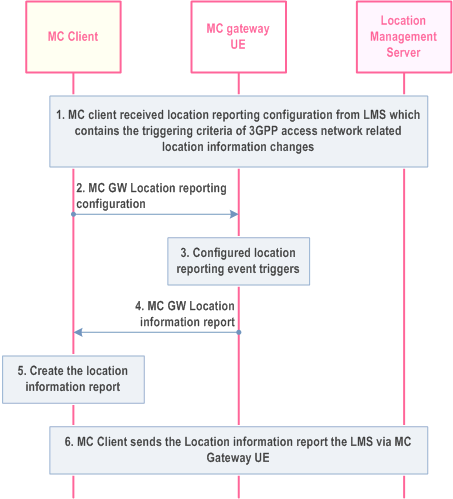
Step 1.
MC client receives the location reporting configuration request from LMS which contains the triggering criteria of 3GPP access network related location information changes.
Step 2.
MC client sends the MC GW location reporting configuration to the MC gateway UE containing the 3GPP access network related location information triggers and the requested location information. MC Gateway UE stores the location reporting configuration and starts monitoring for the triggers as received in the MC GW location reporting configuration.
Step 3.
A location reporting event occurs, triggering step 4.
Step 4.
MC gateway UE sends the MC GW Location information report containing the location information requested by the MC client.
Step 5.
MC client updates the locally available location information with the location information received from the MC gateway UE.
Step 6.
The MC client sends a location information report to the location management server, containing location information identified by the location management server and available to the MC client.
11.5.2.3.2 On-demand location reporting procedure p. 384
The MC client may need to immediately send the location report to the location management sometimes and the requested location information may be related to the 3GPP access network. Under these circumstances the MC client can request the MC gateway UE to report its location information as described in the Figure 11.5.2.3.2-1.
Pre-conditions
- The MC service user wishes to have access to MC services by using a non-3GPP device.
- The MC client successfully completed service authorization via MC Gateway UE.
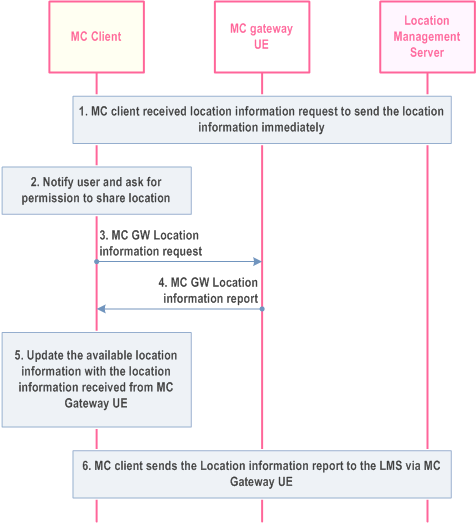
Step 1.
MC client receives the location information request from LMS to send the location information immediately or any other events where it has to send the location report to the location management server immediately like initial login, group call etc. Requested location information includes the location information related to 3GPP access network.
Step 2.
MC service user is notified and asked for permission to share location information. MC service user can accept or deny the request.
Step 3.
MC client sends the MC GW Location information request to the MC gateway requesting for the location information related to the 3GPP access network of the MC gateway UE.
Step 4.
MC gateway UE sends the MC GW Location information report containing the location information requested by the MC client.
Step 5.
MC client updates the locally available location information with the location information received from the MC gateway UE.
Step 6.
The MC client sends a location information report to the location management server, containing location information identified by the location management server and available to the MC client.
11.5.2.3.3 Location reporting cancel procedure p. 385
The location reporting cancel procedure reuses the information flow of location reporting configuration as defined in the subclause 11.5.2.3.1 as described in the Figure 11.5.2.3.3-1.
Pre-conditions
- The MC service user wishes to have access to MC services by using a non-3GPP device.
- The MC client successfully completed service authorization via MC gateway UE.
- The MC client no longer needs the location information report from MC gateway UE.
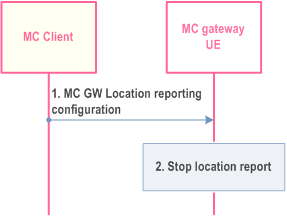
11.5.3 MBMS support for MC clients residing on non-3GPP devices |R19| p. 386
11.5.3.1 General p. 386
This subclause addresses the MBMS support for the MC clients residing on the non-3GPP devices associated with an MC gateway UE. The MC clients instruct the MC gateway UE about the corresponding MBMS bearer details to enable MC gateway listening on them. On demand, MC gateway UE forwards the traffic received over MBMS bearer to the MC clients residing on non-3GPP devices. With the procedure defined in this subclause, MBMS bearer can be supported for the MC clients residing on non-3GPP devices. Changes required are confined to the reference point between MC gateway UE and the MC clients residing on non-3GPP devices. MC service server may consider the location of the corresponding MC clients as defined in subclause 11.5.2 while deciding to establish MBMS bearer.
11.5.3.2 Information flows p. 386
11.5.3.2.1 MC GW MBMS bearer announcement p. 386
Table 11.5.3.2.1-1 describes the information flow from the MC client which resides on a non-3GPP device to the MC gateway UE for sharing the details of MBMS bearer announcement received by the MC Client from the MC Service server.
| Information element | Status | Description |
|---|---|---|
| MC GW service ID | M | The MC GW service ID of the requesting MC client. |
| TMGI | M | TMGI information. |
| List of service area identifier | M | A list of service area identifier for the applicable MBMS broadcast area. |
| Frequency | O | Identification of frequency if multi carrier support is provided. |
| SDP information | M | SDP with media and floor control information applicable to groups that can use this bearer (e.g. codec, protocol id, FEC information). |
| Monitoring state | O | The monitoring state is used to control if the client is actively monitoring the MBMS bearer quality or not. |
| ROHC information | O | Indicate the usage of ROHC and provide the parameters of the ROHC channel to signal to the ROHC decoder. |
11.5.3.2.2 MC GW MBMS listening status report p. 387
Table 11.5.3.2.2-1 describes the information flow from the MC gateway UE to the MC client which resides on a non-3GPP device for the MC GW MBMS listening status report.
| Information element | Status | Description |
|---|---|---|
| TMGI(s) | M | TMGI(s) information. |
| MBMS listening status(s) | M | The MBMS listening status per TMGI. |
| MBMS reception quality level | O | The reception quality level per TMGI. |
| Non 3GPP transport resources establishment parameters (see NOTE) | O | This element contains the details of the non-3GPP transport resources establishment parameters (IP address, Port etc.) which are used by the MC gateway UE to forward the MC service communication traffic received over 3GPP MBMS bearer to the MC client. |
|
NOTE:
These parameters are implementation specific and are dependent on the non 3GPP transport mechanism used between the MC client and MC gateway UE. This parameter can be present mandatorily if the MBMS bearer listening status is success.
|
||
11.5.3.2.3 MC GW MapGroupToBearer request p. 387
Table 11.5.3.2.3-1 describes the information flow from the MC client which resides on a non-3GPP device to the MC gateway UE for sharing the details of MapGroupToBearer message received from the MC service server.
| Information element | Status | Description |
|---|---|---|
| MC GW service ID | M | The GW MC service ID of the MC service user. |
| MCPTT group ID | M | This element identifies the MCPTT group, in which the call is started. |
| Media stream identifier | M | This element identifies the media stream of the SDP used for the group call (e.g. MBMS subchannel). |
| TMGI | M | The MBMS bearer identifier. |
11.5.3.2.4 MC GW MapGroupToBearer response p. 387
Table 11.5.3.2.4-1 describes the information flow from the MC gateway UE to the MC client which resides on a non-3GPP device for the MC GW MapGroupToBearer response.
| Information element | Status | Description |
|---|---|---|
| MapGroupToBearer Status | M | Success or failure response. |
| Non 3GPP transport resources establishment parameters (see NOTE) | M | This element contain the details of the non 3GPP transport resources establishment parameters(IP address, Port etc.,) which are used by the MC gateway UE to forward the MC service Group communication traffic received over 3GPP MBMS bearer to the MC client. |
|
NOTE:
These parameters are implementation specific and are dependent on the non-3GPP transport mechanism used between the MC client and MC gateway UE
|
||
11.5.3.2.5 MC GW MBMS bearer quality report p. 387
Table 11.5.3.2.5-1 describes the information flow from the MC gateway UE to the MC client which resides on a non-3GPP device for the MC GW MBMS bearer quality report.
| Information element | Status | Description |
|---|---|---|
| TMGI(s) | M | TMGI(s) information. |
| MBMS listening status(s) | M | The MBMS listening status per TMGI. |
| MBMS reception quality level | O | The reception quality level per TMGI. |
11.5.3.2.6 MC GW MBMS bearer suspension indication p. 388
Table 11.5.3.2.6-1 describes the information flow from the MC gateway UE to the MC client which resides on a non-3GPP device for the MC GW MBMS bearer suspension indication.
| Information element | Status | Description |
|---|---|---|
| TMGI(s) | M | TMGI(s) information. |
| MBMS suspension status(s) | M | The MBMS suspension status per TMGI. |
11.5.3.2.7 MC GW UnMapGroupToBearer request p. 388
Table 11.5.3.2.7-1 describes the information flow from the MC client which resides on a non-3GPP device to the MC gateway UE for sharing the details of UnMapGroupToBearer message received from the MC service server.
| Information element | Status | Description |
|---|---|---|
| MC GW service ID | M | The GW MC service ID of the MC service user. |
| MCPTT group ID | M | This element identifies the MC service group related to a group call to be dissociated over the MBS session. |
| Media stream identifier | M | This element identifies the media stream of the SDP, which is no longer used for the group call within the MBMS session. |
| TMGI | M | The MBMS bearer identifier. |
11.5.3.2.8 MC GW UnMapGroupToBearer response p. 388
Table 11.5.3.2.8-1 describes the information flow from the MC gateway UE to the MC client which resides on a non-3GPP device for the MC GW UnMapGroupToBearer response.
| Information element | Status | Description |
|---|---|---|
| UnMapGroupToBearer Status | M | Success or failure response. |
11.5.3.3 Procedures p. 388
11.5.3.3.1 Procedure for handling MBMS bearer announcement p. 388
MC clients residing on non-3GPP devices receive MBMS bearer announcements from the MC system, MC clients share the details of the MBMS bearer received in MBMS bearer announcement to the MC gateway UE. This enables the MC gateway UE to start monitoring the corresponding MBMS bearer.
Figure 11.5.3.3.1-1 illustrates the procedure for handling the MBMS bearer announcement by the MC client and the MC gateway UE.
Pre-conditions
- The MC client has been configured with the necessary parameters to enable the use of the MC gateway UE.
- The MC client successfully completed service authorization via MC gateway UE.
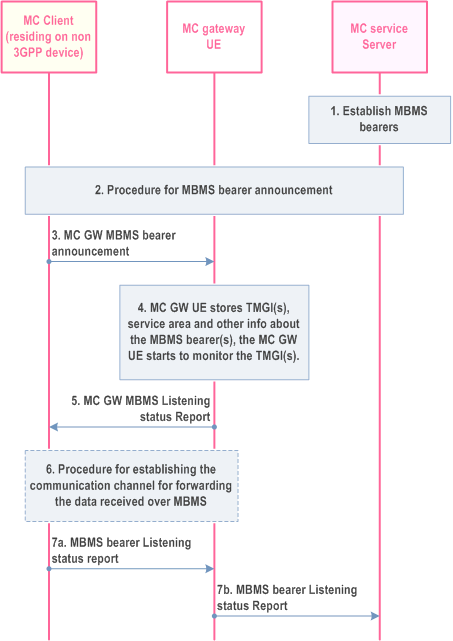
Step 1.
The MC service server establishes the MBMS bearer(s) according to the procedures defined in TS 23.468. Service description associated with the MBMS bearer(s) is returned from the BM-SC.
Step 2.
The MC service server provides service description information associated with the MBMS bearer to the MC client residing on non-3GPP devices via MC gateway UE.
Step 3.
The MC client sends the MC GW MBMS bearer announcement to the MC Gateway UE containing the MBMS bearer related information received from the MC service server.
Step 4.
The MC gateway UE stores the information associated with the TMGI(s). The MC gateway UE uses the TMGI and other MBMS bearer related information to activate the monitoring of the MBMS bearer.
Step 5.
The MC gateway UE that enters or is in the service area of at least one announced TMGI notifies to the MC client that it can receive data over MBMS by sending the MC GW MBMS listening status report. The MC GW MBMS listening status report also contains the details of the non-3GPP transport resources related parameters. The MC gateway UE may choose to send the details of existing transport resources information as part of non-3GPP transport resources establishment parameters IE if existing communication channel can be reused.
Step 6.
The MC client establishes the transport resources with the MC gateway UE based on the parameters received in step 5 to receive the MC service data from the MC gateway UE, if these parameters are not referring to any of the already established transport resources. The MC Gateway UE forwards the MC service data it received over the MBMS bearer from the MC service server to the MC client over this transport resources.
Step 7.
The MC client sends the MBMS Listening Status Report to the MC service server indicating that it is able to receive the media over MBMS.
11.5.3.3.2 Procedure for handling MapGroupToBearer message p. 390
Whenever the MC client detects that traffic received from MC service server is MapGroupToBearer message and if the MC client participates in the group session or communication identified by the MapGroupToBearer message then it should inform the details contained in the MapGroupToBearer message to MC gateway UE. When the association of group call, MBMS bearer and the MC GW service ID of the MC client is known to the MC gateway UE, it can forward the traffic received over MBMS bearer accordingly.
Figure 11.5.3.3.2-1 illustrates the procedure for handling the MapGroupToBearer message by the MC client and the MC gateway UE.
Pre-conditions
- The MC client has been configured with the necessary parameters needed for connectivity with the MC gateway UE.
- The MC client successfully completed service authorization via MC gateway UE.
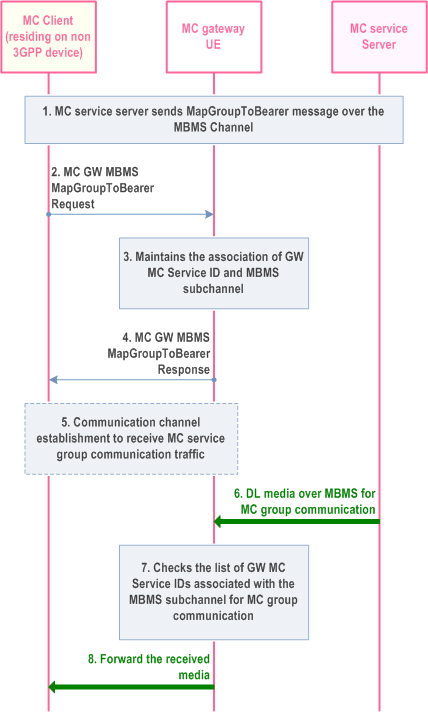
Step 1.
The MC service server sends a MapGroupToBearer message over a previously activated MBMS bearer to all users that will receive the call over an MBMS bearer. The MapGroupToBearer message includes association information between the group call and MBMS bearer. The MapGroupToBearer message includes MC service group ID and information about the media stream identifier of the activated MBMS bearer and may include the identifier (i.e. the TMGI) of the MBMS bearer broadcasting the call.
Step 2.
If the MC client is participating in the MC group communication identified by the MapGroupToBearer message, it sends the details contained in the MapGroupToBearer message to the MC gateway UE through MC GW MapGroupToBearer request message.
Step 3.
The MC gateway UE on receiving the MC GW MapGroupToBearer Request message from the MC client it maintains the association between the GW MC Service ID and the corresponding MBMS sub channel.
Step 4.
The MC gateway UE sends the MC GW MapGroupToBearer response message to the MC client which contains the details of the non-3GPP transport resources related parameters. The MC gateway UE may choose to send the details of existing communication channel information as part of non-3GPP transport resources establishment parameters IE if existing transport resources can be reused.
Step 5.
The MC client establishes the communication channel with the MC gateway UE based on the parameters received in step 4 to receive the MC service group communication data from the MC gateway UE, if these parameters are not referring to any of the already established transport resources. The MC Gateway UE forwards the MC service group communication data it received over the MBMS bearer from the MC service server to the MC client over this transport resources.
Step 6.
The MC service server sends the downlink media for the group communication session over the MBMS bearer.
Step 7.
The MC gateway UE checks which MC clients should receive the media of the MC group communication based on Step 3.
Step 8.
The MC gateway UE forwards the downlink media to the intended MC clients over the transport resources established as in step 5.
11.5.3.3.2A Procedure for handling UnmapGroupFromBearer message p. 391
Whenever the MC client receives UnmapGroupFromBearer message and if the MC client participates in the group session or communication identified by the UnmapGroupFromBearer message then it should inform the details contained in the UnmapGroupFromBearer message to MC gateway UE. When the association of group call, MBMS bearer and the MC GW service ID of the MC client is known to the MC gateway UE, it can remove the association and stop forwarding of the traffic received over MBMS bearer accordingly.
Figure 11.5.3.3.2A-1 illustrates the procedure for handling the UnmapGroupFromBearer message by the MC client and the MC gateway UE.
Pre-conditions:
- The MC client has been configured with the necessary parameters needed for connectivity with the MC gateway UE.
- The MC client successfully completed service authorization via MC gateway UE.
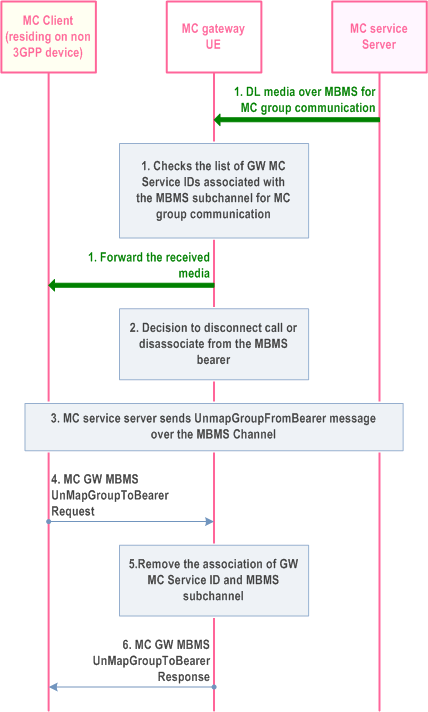
Step 1.
An MCPTT group call is ongoing; the MC gateway UE forwards the downlink media to the intended MC client over the transport resources established.
Step 2.
MCPTT server has determined to disconnect the call over the MBMS bearer for the MC client.
Step 3.
An UnmapGroupFromBearer message is sent by the MCPTT server to MC client (if in MBMS coverage area) on MBMS bearer(s).
Step 4.
If the MC client is participating in the MC group communication identified by the UnmapGroupFromBearer message, it sends the details contained in the UnmapGroupFromBearer message to the MC gateway UE through MC GW UnMapGroupToBearer request message.
Step 5.
The MC gateway UE on receiving the MC GW UnMapGroupToBearer Request message from the MC client it removes the association maintained between the GW MC Service ID and the corresponding MBMS sub channel.
Step 6.
The MC gateway UE sends the MC GW MapGroupToBearer response message to the MC client.
11.5.3.3.3 Procedure for MBMS bearer suspension notification p. 392
The MC service server can choose to instruct some MC clients to send the MBMS bearer suspension report when notified by RAN. When the MC clients are residing on non 3GPP devices, MC gateway UE would be the one listening on the MBMS bearers. When RAN decides to suspend the MBMS bearer it indicates the MC gateway UE. MC gateway UE to notify the MC clients it is serving so that MC clients can report the same to the MC service server. This procedure is applicable only if the MC client is instructed to report the MBMS bearer suspension. Irrespective of whether the MC clients need to send the MBMS bearer suspension report to the MC service server, MC gateway can choose to notify the MC clients it is serving whenever RAN suspends the MBMS bearer. MC clients can then decide to send the MBMS bearer suspension report to the MC service server only if they are instructed by the MC service server.
Figure 11.5.3.3.3-1 illustrates the procedure for MC clients residing on non-3GPP devices reporting the MC service server about the MBMS bearer suspension.
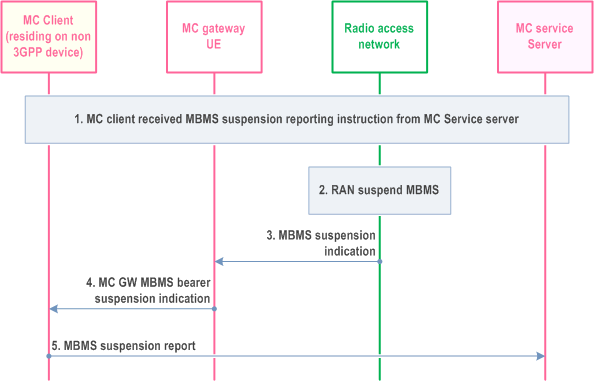
Step 1.
The MC service server sends an MBMS suspension reporting instruction to the MC client residing on non-3GPP device.
Step 2.
RAN decides to suspend the MBMS bearer, according to existing procedures in TS 36.300.
Step 3.
An MBMS suspension indication is sent to the MC gateway UE in the MSI (MCH Scheduling Information), according to existing procedures in TS 36.300.
Step 4.
The MC gateway UE detect the MBMS suspension and sends an MC GW MBMS suspension indication to the MC Client residing on non-3GPP device.
Step 5.
The MC client MBMS suspension report to the MC Service server via MC gateway UE.
11.5.3.3.4 Procedure for reporting MBMS bearer quality p. 393
The MC gateway UE listening on the MBMS bearer has to report the MBMS bearer quality to the MC clients so that MC clients can report the same to the MC service server. MC Gateway UE monitors an MBMS bearer to receive MC service media. Based on the received quality (e.g. radio level quality) the MC gateway UE needs to inform the MC Clients which requested the MC gateway UE to listen on MBMS bearer, whether it is able to receive the MC service media on the MBMS bearer with sufficient quality or not the MC Clients can inform the MC service server accordingly.
Figure 11.5.3.3.4-1 illustrates the procedure for MC clients residing on non-3GPP devices reporting the MC service server about the MBMS bearer quality.
Pre-conditions
- There is an MBMS bearer activated and the MBMS bearer information is announced to the MC gateway UE.
- The MC gateway UE is located in the MBMS broadcasting area
- The MC gateway UE monitors SIB-13 (or SIB-20) and (SC-)MCCH to receive the modulation and coding scheme.
- The MC gateway UE monitors the cell specific reference signal and when MBSFN transmission is used, the MBSFN specific reference signals.
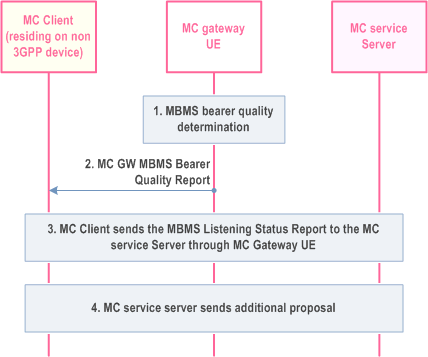
Step 1.
The MC gateway UE follows the Step 1 of the procedure as described in clause 10.7.3.6.2 for the MC service UE. The corresponding MBMS bearer quality information is forwarded to all the MC clients which have asked the MC gateway UE to listen on the particular MBMS bearer.
Step 2.
If the MBMS bearer quality reaches a certain threshold, the MC gateway UE sends an MC GW MBMS bearer quality report to the MC client. The threshold is used to define the MBMS listening status, which indicates if the MBMS bearer quality has been acceptable or not to receive a specific MC service media. If the MBMS bearer quality is mapped to a different MBMS reception quality level, the MC gateway UE may send an MBMS Bearer Quality report including the MBMS reception quality level to the MC Client.
Step 3.
The MC Client sends the MBMS listening status report to the MC Service server via MC gateway UE containing the information received in the MC GW MBMS bearer quality report.
Step 4.
The MC service server may send an additional proposal for measurements e.g. information about neighbouring MBMS bearers. This message may be an MBMS bearer announcement message.